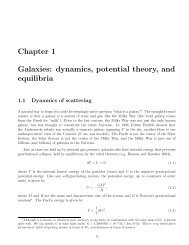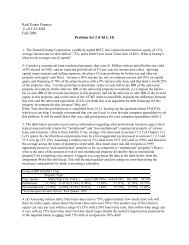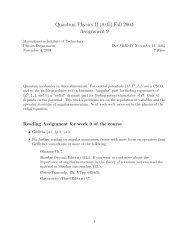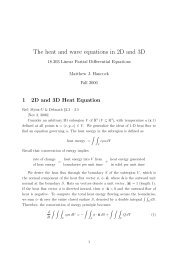Problem Set 2 Answer Key
Problem Set 2 Answer Key
Problem Set 2 Answer Key
Create successful ePaper yourself
Turn your PDF publications into a flip-book with our unique Google optimized e-Paper software.
<strong>Problem</strong> <strong>Set</strong> 2 <strong>Answer</strong> <strong>Key</strong><br />
1) Good job on this part. Everyone did well.<br />
Basic requirements for this question:<br />
0.5 dpm = 262800 decays/y<br />
t 1/2 ( 210 Pb) = 22.3 y<br />
λ ( 210 Pb) = 0.0311 y -1<br />
t 1/2 ( 231 Pa) = 32760 y<br />
λ ( 231 Pa) = 2.166 x 10 -5 y -1<br />
a) For counting techniques:<br />
N 210 = (262800 decays/y)/(0.0311 y -1 ) = 8.45 x 10 6 atoms < 10 8<br />
N 231 = (262800 decays/y)/(2.116 x 10 -5- y -1 ) = 1.242 x 10 10 atoms > 10 8<br />
Use counting techniques for 210 Pb and mass spectrometry for 231 Pa.<br />
b) For 210 Pb:<br />
10 8 – 8.45 x 10 6 = 9.16 x 10 7 atoms<br />
or<br />
(8.45 x 10 6 )/10 8 = 8 %<br />
For 231 Pa:<br />
1.242 x 10 10 – 10 8 = 1.232 x 10 10 atoms<br />
or<br />
10 8 /(1.242 x 10 10 ) = 0.8 %<br />
c) Mass spec. becomes advantageous when the activity is less then the number of<br />
atoms times the decay constant.<br />
A < N*ln(2)/t 1/2<br />
A = 0.5 atoms/minute = 2.628 x 10 5 atoms/y<br />
N = 10 8 atoms<br />
t 1/2 (minimum) = N*ln(2)/A = (10 8 atoms)*ln(2)/(2.628 x 10 5 atoms/y) = 264 years<br />
2) This question has some subtleties that not everyone picked up on. Everyone did<br />
very well using the basic equations. The problems stemmed from two parts: the<br />
assumption of secular equilibrium and the use of relative abundances.<br />
Isotope t 1/2 (y) λ (y -1 ) Ratio vs. 238 U at t = 0<br />
238 U 4.468 x 10 9 1.551 x 10 -10 1<br />
235 U 7.038 x 10 8 9.849 x 10 -10 0.00725<br />
234 U 2.455 x 10 5 2.823 x 10 -6 0.0000554<br />
The relative abundances that are given in this question cannot just be plugged in to the<br />
decay equation. The decay equation calls for N, which is in atoms. However, if we
create a hypothetical situation that we assume that there are 100 atoms of U today. So<br />
there would be 99.2745 atoms of 238 U, 0.7196 atoms of 235 U and 0.0055 atoms of 234 U.<br />
From this we can calculate the number of atoms of each at t = 0. However, this is not the<br />
‘ideal’ way to do this, because we make some assumptions that we don’t have to make<br />
(however, this was an acceptable answer). So, here we go on the preferable method:<br />
238 U and 235 U are the start of two decays series. Therefore, they were produced during<br />
nucleosynthesis, and have no other source (well, other than us… but we will ignore<br />
human additions for now). So to calculate the amounts of these at t = 0 we can use the<br />
equation:<br />
N = N o e -λt<br />
However, we don’t have the number of atoms, but we do have their relative abundances,<br />
and through that we have the abundances relative to each other.<br />
238 N = 238 N o e -λ238*t<br />
235 N 235 N o e -λ235*t<br />
238 N/ 235 N = R<br />
[-(λ238 - λ235)*t]<br />
R o = Re<br />
R o = (0.00725)*e<br />
R o = 0.323<br />
235 N o = 0.323 * 238 N o<br />
[-(9.849E-10 – 1.551E-10)*4.6E9]<br />
The next step is to make an assumption about 234 U. 234 U is produced during<br />
nucleosynthesis and in the decay series of 238 U. However, we can simplify the problem<br />
by assuming that at t = 0 234 U is in secular equilibrium with 238 U. Now is this a good<br />
assumption? Well, that issue is addressed by considering the half-life of 234 U and the<br />
length of time between nucelosynthesis and the formation of the earth. It turns out that<br />
234 U’s half-life is short compared to the time of earth formation, so our assumption is<br />
good. With this assumption made we can state:<br />
234 N o λ 234 = 238 N o λ 238<br />
234 N o = (λ 238 /λ 234 ) 238 N o<br />
234 N o = (1.551 x 10 -10 /2.823 x 10 -6 ) * 238 N o<br />
234 N o = (5.494 x 10 -5 ) * 238 N o<br />
Now we know the relative amounts of each isotope at t = 0, relative to 238 U. And we<br />
know that the three isotopes add up to the total amount of U (100%). Since we are<br />
looking for the relative abundances of each isotope at t = 0, we solve as follows:<br />
238 U + 235 U + 234 U = U T<br />
238 N + 0.323( 238 N) + 5.494 x 10 -5 ( 238 N) = N T<br />
238 N/N T + 0.323( 238 N/N T ) + 5.494 x 10 -5 ( 238 N/N T ) = 1<br />
1.323( 238 N/N T ) = 1<br />
238 U = 1/1.323 = 75.6%
235 U = 0.323(75.6%) = 24.4%<br />
234 U = 5.494 x 10 -5 (75.6%) = 0.415%<br />
3. Every did a pretty good job with this question, too. Some small problems arose<br />
on the last part, but we will get to that later. To start, the basis behind all the parts to this<br />
problem is obviously in = out. Similar to the assumptions we make with steady state, in<br />
this case we make the assumption that the earth maintains a radiative balance.<br />
a) No atmosphere. So in this case we have a very simple model. The energy that<br />
comes into the earth (F in ) with is reflected back to space (αF in ) or is absorbed by the earth<br />
and re-emitted (S).<br />
F in = F out<br />
F in = S o /4 = 342 W/m 2<br />
F out = αF in + S<br />
F in = αF in + S<br />
S = (1-α)F in<br />
S = 0.67*342 W/m 2<br />
S = 229.14 W/m 2<br />
T S = (S/σ) 1/4<br />
T S = [(229.14 W/m 2 )/(5.7E-8 W/m 2 K 4 )] 1/4<br />
T S = 252 K<br />
b) Now it gets a bit more complicated, we need to assume a homogeneous<br />
atmosphere that allows the incoming solar radiation to pass through it, but absorbs all of<br />
the outgoing planetary radiation. The sketch should make it clear that the atmosphere is<br />
also transparent to the reflected solar radiation – remember, it has the same wavelength as<br />
the incoming solar radiation. It is not until the energy is absorbed and re-radiated that the<br />
energy can be absorbed by the atmosphere.<br />
Energy balance at the surface:<br />
Energy balance of the atmosphere:<br />
F in + A = αF in + S<br />
S = 2A<br />
F in + A = αF in + 2A<br />
A = F in (1-α)<br />
T A = [(342 W/m 2 * 0.67)/(5.7E-8 W/m 2 K 4 )] 1/4 = 252 K<br />
T S = (2*4.02E+9 K 4 ) 1/4 = 299 K<br />
c) Now things get even more complicated – the atmosphere no longer completely<br />
absorbs the planetary radiation, but only a portion of it (ε).<br />
Energy balance at the surface:<br />
Energy balance of the atmosphere:<br />
F in + A = αF in + S<br />
S = (1-α)F in + A<br />
S = 2A + (1-ε)S
S = 2A/ε<br />
S = S<br />
(1-α)F in + A = 2A/ε<br />
A = (1-α)F in /((2/ε) - 1)<br />
A = 169.4 W/m 2<br />
S = 398.6 W/m 2<br />
T A = (A/σε) 1/4 = 243 K<br />
T S = (S/σ) 1/4 = 289 K<br />
d) The discrepancy between the observed temperature of the earth’s surface and the<br />
calculated temperature (above) is due to the assumptions and simplifications that we<br />
made in order to answer the question. The main simplification is that the atmosphere is a<br />
single homogenous box. It is, of course, far more complicated, and this can have a large<br />
effect on the temperature of the earth’s surface.<br />
4. I tried to comment on each of your problem sets. If there are any additional<br />
questions do not hesitate to contact me. Here are some general answers:<br />
(10) a) Winds tend to flow along lines of constant pressure (isobars), and flow the<br />
most quickly when the isobars are closely set. The air wants to move from areas<br />
of high pressure to areas of low pressure, but the rotation of the earth causes the<br />
Coriolis effect and the winds are deflected to the right (left) in the Northern<br />
(Southern) hemisphere.<br />
(10) b) The main point here was that the two maps are not sampled<br />
simultaneously, nor are they updated with the same frequency (5). This inevitably<br />
leads to discrepancies between the two maps, though the large-scale features are<br />
generally accurate. Also, the NCEP map is a analysis map (a compilation of data<br />
that is analyzed by the NOAA scientists to give that maps posted on the website),<br />
while the QuikSCAT map is an observation. They serve different purposes and<br />
contain different information (5).<br />
(5) c) The climatological fields that were discussed in class are the long-term<br />
averaged wind speeds and directions. The QuikSCAT map is instantaneous and<br />
discrete. Therefore variations that are small in time and space, but large in<br />
magnitude may not show up on a climatological field. This is important in gas<br />
exchange (as you will soon see) because it is dependant upon wind speed in a<br />
non-linear fashion. For example, storms are not included in climatological fields<br />
and they have very large effects on the amount of gas exchange that occurs over a<br />
finite time period. So an estimate of gas exchange based on climatological fields<br />
could be drastically inaccurate.

















